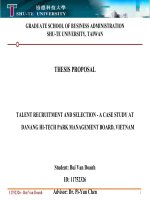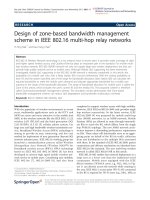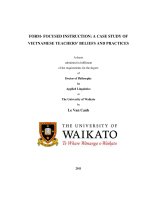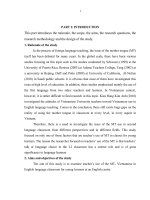Case Study: republic of koreas emissions target management scheme
Bạn đang xem bản rút gọn của tài liệu. Xem và tải ngay bản đầy đủ của tài liệu tại đây (439.06 KB, 5 trang )
Low Carbon Green Growth Roadmap for Asia and the Pacific
CASE STUDY
Easing into carbon trading
Republic of Korea’s Emissions Target Management Scheme
Key point
•
The Emissions Target Management Scheme is a tool for a smoother transition to the Emissions Trading
Scheme.
There was a need for a transition…
The Korean Government’s National Strategy for Green Growth and Five-Year Plan called for a shift from voluntary commitments by companies to market-based instruments limiting their greenhouse gas emissions. Some 468
entities whose greenhouse gas emissions amount to 60 per cent of the total national emission were targeted to
reduce either the amount of greenhouse gas they emit or the amount of energy they consume. There was concern, however, that instituting an emissions trading scheme right away would lead to negative impacts on
business if there was no preparatory phase.
What was done?
To help companies make a smoother transition to a low carbon enterprise and minimize the potential negative
impacts on their business, the Emissions Target Management Scheme was mandated by the Basic Law on Green
Growth and guidelines were stipulated in accordance with the Directive on the Operation of Emission Target
Management Scheme (March 2011). The Emission Target Management Scheme was adopted to provide
precise and fair reduction targets and to create an enabling environment for introducing the future Emissions
Trading Scheme.
According to the reduction target, the overall national emissions will reach its highest level in 2014 and start to
decrease from 2015, which will enable the decoupling of emissions from economic growth. The annual net cost
to meet the target is expected to reach US$1.6 billion per year and cumulate up to US$14 billion by 2020.
Although GDP is projected to decline by 0.5 per cent by 2020 compared with 2011, according to the roadmap
scenario,1 allocating a carbon-related fiscal budget to R&D investment will generate a surplus in the midterm
due to technological advancement impacts.
Figure 1: Annual greenhouse gas emissions reduction scenario
Scenario
1
Kyungho Lee, “Confirmation of a Road Map to Reduce 30% National GHGs Emission: Expected Cost for 14 trillion Won by 2020”. The Aisa
Economy, 12 July 2011. Available from www.asiae.co.kr/news/view.htm?sec=eco3&idxno=2011071209173541812 (accessed 17 August
2011) [in Korean].
Low Carbon Green Growth Roadmap for Asia and the Pacific :
Case Study - Republic of Korea’s Emissions Target Management Scheme
Note: BAU: business as usual; Scenario: as laid out in the Emissions Target Management Scheme
Source: Korean Government official policy web portal, “Sectoral yearly target setting of greenhouse gases emission for 2020 low carbon
green growth roadmap”(2011).
To reduce the business-as-usual level of greenhouse gas emissions (estimated at 813 million tons by 2020),
specific reduction targets are designated to 25 businesses in seven sectors:2
1) electricity generation
2) industry
3) transport
4) building
5) agriculture and fisheries
6) waste
7) public and others.
Institutional arrangement
The Ministry of Environment is in charge of the overarching framework, coordinating line ministries and building
up the enabling conditions, such as setting standards, drafting guidelines and managing verifying agencies.
Engaged ministries select entities to be subjected to the scheme per sector, set targets based on negotiations
and evaluate performance records.3 The system will be supported by the National Greenhouse Gas Inventory
System, managed by the Greenhouse Gas Inventory & Research Center for Korea, track greenhouse gases emitted by entities and provide the data required for measuring, reporting and verifying, in line with an international
standard.
The Emissions Target Management Scheme is one of the policy options for creating an enabling condition for the
future introduction of the Emissions Trading Scheme, which will aim to mitigate national greenhouse gas emissions. The Government (through different ministries) set up the physical and legal infrastructure for the scheme’s
operation. For example, the Ministry of Environment released guidelines on methodologies.4
Prior to the 2012 enforcement of the Emissions Target Management Scheme, the preparatory work included the
targeting of businesses, submission of emissions records and verification reports, setting the targets and submission of implementing plans. Targeted businesses were given until March 2012 to submit a performance report
and details; assessments will be conducted in June. Orders to improve will be issued where required.
Preparatory measures prior to introducing the Emissions Trading Scheme
•
Targets are negotiated: Entities can reflect their needs and circumstances, such as future investment
plan, onto their target setting. Targets based on average emissions for the latest three years will be
negotiated every five years.
•
A phase-by-phase approach is introduced to reduce resistance from the private sector while building
capacity and confidence: The Emissions Target Management Scheme is expected to help companies
take proactive actions in mitigating their greenhouse gas emissions and invest in energy-efficiency
improvements.5
2
ibid.
3
Ministry of Knowledge and Economy for 374 entities from energy and industrial sector, Ministry for Food, Agriculture, Forestry and Fisheries
for 27 entities agriculture and forestry sectors, Ministry of Land, Transport and Marine Affairs for 46 entities from building/transportation,
Ministry of Environment for 23 entities from waste sector.
4
Guideline for the Measurement, Reporting and Verification, a list of entities to be complied with the greenhouse gas target management, how to set targets, etc.
5
The Korean Government decided to postpone the implementation of the Emissions Trading Scheme to 2015, originally to be introduced
in 2013, due to concerns for losing business competitiveness as well as resistance from the private sector.
Low Carbon Green Growth Roadmap for Asia and the Pacific :
Case Study - Republic of Korea’s Emissions Target Management Scheme
To gain support from the private sector for the Emissions Target Management Scheme, the Government
sought input when developing the system through more than 100 consultations with actors in the private
sector. To help relieve resistance, the Government initially lowered the penalty for non-compliance
(down to US$8,800 maximum).6 However, having met criticism on the stringency of that penalty, the
Government recently announced intent to strengthen it. With public awareness growing on the
increased danger of global warming, there is also a growing consensus among industries on the need
to reduce emissions from their business practices.
•
Government sets the rules and determines the sequence of phases: There are complementary measures
for minimizing potential negative impacts on companies’ competitiveness, such as:
o Simplifying the procedure required for reporting greenhouse gas emissions for relatively small
emitters.
o Provide flexibility in reducing greenhouse gas emissions. The Government credits emission
reductions prior to the official enforcement of the system. Reduction activities carried out beyond
the boundary, such as big companies helping small companies in their supply chain to reduce
greenhouse gas emissions, will be counted.
•
International measuring, reporting and verifying standards are benchmarked for business opportunities
in the carbon market: Applying international standards to the domestic measuring, reporting and
verifying system reduces time and cost while building confidence within the private sector. The Emissions
Target Management Scheme mandates the entities to measure their greenhouse gas emissions, to
submit their performance report and to be verified, based on standards corresponding to the international benchmark. By mandating companies to conform to the international standard from the beginning, companies become better prepared to participate in both the domestic and international
carbon markets.
Success factors
•
•
•
•
Consistent policy direction: Clear policy direction was presented to targeted industries that will be
subjected to the Emissions Target Management Scheme through public hearings and consultations
before its enforcement.
Financial incentives and consulting services: The Government provides consulting services for small and
medium-sized enterprises to help them set up an inventory and energy management system. Financial
incentives are provided in the form of loans through energy service companies for energy efficiency
improvement projects. Early mitigation actions taken by industries have been acknowledged.
Verification professionals: The Government is keen to nurture professional verifiers and has deployed
education and training programmes and imposed qualification standards for verification bodies.
Coordination among ministries: Coordination among ministries is key to the successful application of the
scheme. A regular consultation meeting was arranged for discussion on issues raised within each sector.
Additionally, the emission target management scheme has clearly defined roles of work.
Expected results
For the transport sector, greenhouse gas emissions should be reduced by 34.3 per cent compared with the
business-as-usual level of 2020, along with 26.9 per cent for building, 26.7 per cent for electricity generation, 25
per cent for public sector, 18.2 per cent for industry, 12.3 per cent for waste and 5.2 per cent for agriculture and
fishery. Among the 25 industries (figure 2), electrical/electronics industry is mandated to reduce 61.7 per cent of
its greenhouse gas emissions, which is the highest target, followed by display (39.5 per cent), automobile (31.9
per cent) and semiconductor (27.7 per cent).7
6
Heeyoon Park, “Government Takes Stances on Strengthening EMTS”, Anjun Journal, November 23, 2011. Available from
www.anjunj.com/news/articleView.html?idxno=4027 (accessed 12 December 2011).
7
Kyungmin Kang, “Greenhouse Gas Emission Reduction Target of 62% for Electricity and Electronics Sector: Target Allocation for 471
Enterprises by September”, The Korea Economic Daily, 12 July 2011. Available from
www.hankyung.com/news/app/newsview.php?aid=2011071230591 (accessed 17 August 2011) [in Korean].
Low Carbon Green Growth Roadmap for Asia and the Pacific :
Case Study - Republic of Korea’s Emissions Target Management Scheme
Table 1: Greenhouse gas emissions reduction rate compared with business-as-usual practices, by 2020 (unit: %)
Industry
Electricity
generation
Transport
Building
Agriculture/
fisheries
Waste
Public/
others
Total national
reduction
18.2
26.7
34.3
26.9
5.2
12.3
25
30
Figure 2: Industry greenhouse gas emissions reduction target(unit: %(millions)
Electrical/electronics
61.7 (25 510)
Display
39.5 (28 320)
Automobile
31.9(3 940)
Semiconductor
27.7(4 030)
Concrete
8.5(3530)
Machinery
7.6(990)
Petrochemicals
7.5(4770)
Oil refinery
7.5(1280)
Shipbuilding
6.7(250)
Steel
6.5(7880)
Note: The order is by reduction percentage, compared with business as usual by 2020; the figure in the parenthesis is the net reduction
amount.
Source: Kyungmin Kang, “Greenhouse Gas Emission Reduction Target of 62% for Electricity and Electronics Sector: Target Allocation for 471
Enterprises by September”, The Korea Economic Daily, 12 July 2011. Available from
www.hankyung.com/news/app/newsview.php?aid=2011071230591 (accessed 17 August 2011) [in Korean].
Remaining issues
•
•
•
8
Because entities are categorized on a sector basis and managed by line ministries, the role of the Ministry
of Environment in coordinating all ministries is critical to avoid any potential overlapping burden on
companies.
There should be a clear arrangement between the Emissions Target Management Scheme and the
Emissions Trading Scheme to give a consistent message to the private sector and relieve companies’
concerns that they will be controlled by both of them. The Government announced that entities whose
emissions amount to more than 25,000 tons of CO2 will not be targeted by the Emissions Target
Management Scheme but by the Emissions Trading Scheme as of 2015.8
Several incentives for companies that reduce emissions beyond their targets are under consideration,
such as acknowledgement of early mitigation actions for the Emissions Trading Scheme and awards for
best performers.
Greenhouse Gas Inventory & Research Center of Korea, “Greenhouse Gas Target Management”. Available from
www.gir.go.kr/eng/og/hm/nc/a/OGHMNCA010.do (accessed 20 February 2012)
Low Carbon Green Growth Roadmap for Asia and the Pacific :
Case Study - Republic of Korea’s Emissions Target Management Scheme
Considerations for replicating
Emissions trading schemes can be a jolt to some businesses. They need time to prepare both mentally and physically do changing the way they operate. A transition scheme can muffle the impact and ease businesses to
making the necessary change. In the Republic of Korea, the Emissions Target Management Scheme is expected
to help companies take proactive action in mitigating their greenhouse gas emissions and invest in energyefficiency improvements while preparing for the next, more stringent measure – the Emissions Trading Scheme.
Further reading
Greenhouse Gas Target Management (Seoul, Greenhouse Gas Inventory & Research Center of Korea, 2010).
Available from www.gir.go.kr/eng/og/hm/nc/a/OGHMNCA010.do.









